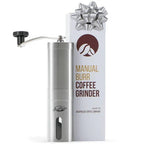In the specialty coffee world, we love our coffee scales.
They tell us exactly how much coffee and water we’re using, which allows us to be super precise, helps us dial in our brew’s flavor, and enables us to make every single cup as delicious as the one before.
But we also realize that not everyone has a kitchen or coffee scale. And, especially when you’re still new to coffee, the $20 purchase can seem overkill.
I get it—I avoided getting a scale myself for several months once I started home brewing. During that time, I realized that I didn’t have to sacrifice precision—not completely. You can still have control over your daily brew using tools other than a scale, like a measuring cup and tablespoon scoops, for example.
I’m going to show you how you can use these two tools (that you probably already have) to brew rich, balanced coffee that’s satisfying and life-enhancing—no scale required.
Your Goal: The Golden Ratios
While there’s no objective best ratio of coffee to water, there is a range that most people agree on as the ‘sweet spot’.
Here are the Golden Ratios: 1 gram of coffee to 15-18 grams of water (1:15-18).
Read: Why You Need To Be Drinking Coffee Black (And How To Start)
In this range…
- The acids and bitter notes balance each other out
- The sweet sugars are pleasant and refreshing
- The coffee tastes balanced and all the elements are in harmony
If you use more water (a 1:22 ratio, for example), you risk the coffee becoming too weak but overly bitter. If you use too little water (a 1:11 ratio), the coffee will be too concentrated and sour. The golden ratio range keeps all the elements in check and balanced.
How To Use The Ratios With Volume Measuring
With a scale, using the golden ratios is easy—you just weigh the beans and water, and the scale tells you exactly how much there is.
Without a scale, we’ve got to get just a bit creative.
Here are the two tools you should have on hand.
- Tablespoon - Generally, a level tablespoon of whole coffee beans is roughly 4-7g of coffee. To keep things rather simple, just assume it’s 5g each level scoop.
- Liquid Measuring Cup - 1g of liquid water is exactly 1ml of liquid water. The two units of measurement are based on each other, which is why it’s a direct translation.
Read: The Easy Guide to Coffee Bean Storage
If you’d like a single 8oz mug of coffee, here’s how to find your coffee to water ratio:
- 8oz of coffee is about 225ml, measure 225g of water in your liquid measuring cup and pour into your kettle.
- For practice sake, let’s say you’re using a 1:15 ratio (it’s golden). Divide your total water weight by the ratio (225 / 15) to produce 15. That’s the amount of coffee you need (15g).
- You now know that, if you’re using a 1:15 ratio, you’ll need 15g of coffee and 225g of water to brew your 8oz mug.
- Since you’re assuming each level tablespoon holds 5g of coffee, divide the total coffee weight by 5 to see how many tablespoons you need (15 / 5). You need 3 level tablespoons of coffee beans.
Read: Skip The Coffee Aisle, Here's How To Find The World's Best Coffee
What if you want three 8oz mugs of coffee?
- 24oz of coffee is about 680ml of liquid, which is how much water you’ll measure using your liquid measuring cup.
- To use a 1:17 ratio, divide the total water weight by 17 to find out how much coffee you need (680 / 17 = 40). You need 40g of coffee.
- Now divide the coffee total by 5 (since each level tablespoon holds 5g of coffee beans) to discover how many tablespoons you need to use (40 / 5). You need 8 level tablespoons of whole bean coffee.
What if you have 6 level tablespoons of coffee and want to know how much water to use?
- Multiply the 6 tablespoons by 5 to calculate that you have 30g of coffee.
- Now multiply your coffee bean total by the golden ratio (in this case, 1:16).
- 30g of coffee multiplied by 16 is 480. You need 480ml of water to brew those 30g of coffee at a 1:16 ratio.
Read: 3 Reasons Buying Cheap Coffee Is Bad For The World
As you can see, the math really isn’t difficult. It just takes thirty seconds or so to think through it if you have a calculator on your phone. I also suggest writing down a handful of recipes and ratios on a cheat sheet. That way, you don’t have to redo the math all the time.
To figure out which of the Golden Ratios is best for you, check out The Golden Ratios in Coffee Brewing.
The Limitations of Volume Measuring
This method works, but it’s only so precise.
Remember how you have to assume that a level tablespoon equals 5g of coffee beans? That’s not going to be true 100% of the time.
You see, coffee beans come in all sizes. One coffee from Panama may be super tiny and another from Indonesia can be twice the size.
But size isn’t the only issue, there’s also density. A tablespoon of one coffee may just be 4g of coffee. A tablespoon of a different coffee can be as much as 7g of coffee (and yet, the beans can even look the exact same size).
How The Limitations Affect You
So here’s how the issue affects you in a regular week:
One day you brew coffee that weighs 5g per tablespoon, You use a 1:16 ratio, the coffee tastes great, and all is right in the world. A couple days later you open a new bag, but you don’t realize that each tablespoon doesn’t weigh 5g anymore—it weighs 7g.You use a 1:16 ratio, but the coffee has a harsh sour punch to it.
Read: How To Taste Coffee Acidity
Here’s what happened:
You ended up using 5-10 extra grams of coffee without realizing it. That extra coffee took your ratio from 1:16 to 1:12. And since each drop of water couldn’t pull out the right amount of “stuff” from each coffee ground (because there’s a whole lot of extra coffee), the lower notes weren’t extracted, causing the sour acids to be overpowering.
Here’s the main point: careful measuring with volume is so much better than not really trying to measure at all, but it’s not nearly as precise as using a coffee scale. If you really want to explore the riches of coffee at a high level, I strongly suggest investing in a scale eventually.
Read: How To Taste Coffee Bitterness
---
Here’s the thing: just putting in a little bit of effort here goes a looong way. Your coffee will taste better, it’ll be more consistent from day-to-day overall, and your morning mug will make you happier than ever before.
Use the ratios, brew your coffee like you mean it, and savor the rich results.
And the nice thing is, freshly roasted, specialty-grade coffee tends to be pretty forgiving. The flavors are so rich and balanced that they can handle little ratio mess-ups from volume measuring. So as long as you’re pretty close to those Golden Ratios, you’re going to have a stellar cup.




